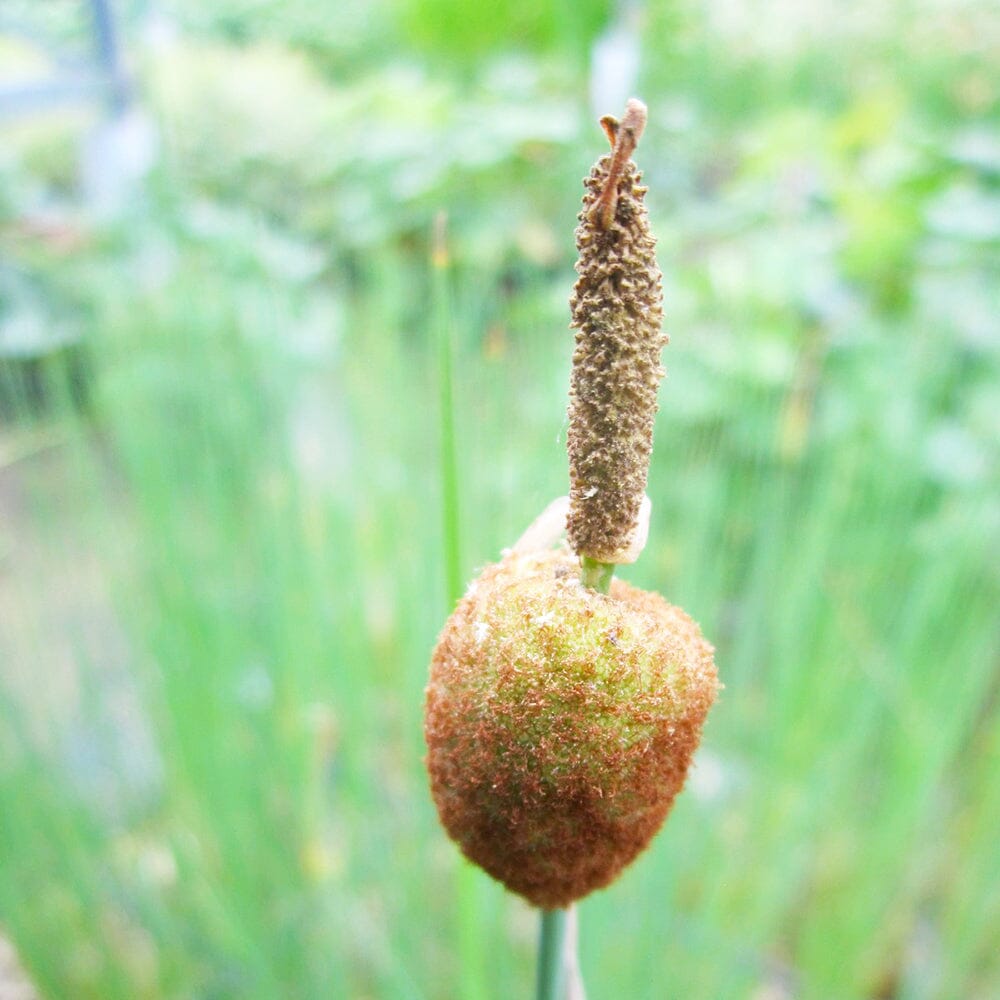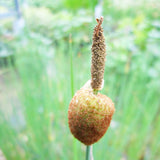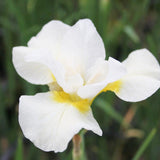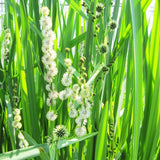Typha Minima Aquatic Pond Plant - Laxmann's Bulrush
Typha laxmannii, commonly known as Laxmann's Bulrush, is a perennial aquatic plant belonging to the Typhaceae family. It is native to wetland habitats and is characterized by its tall, erect growth and distinctive brown flower spikes. Here's a detailed description and care guide for Typha laxmannii:
Description:
Typha laxmannii forms large clumps of tall, erect stems that can reach heights of 3-6 feet (1-2 meters). The stems are slender and unbranched, with long, narrow leaves that grow along the length of the stem. The leaves are typically green and have a parallel arrangement. The plant produces unique cylindrical flower spikes that emerge from the top of the stems. The flower spikes are densely packed with tiny, brownish florets. The male and female flowers are separated on the spikes, with the male flowers located at the top and the female flowers located below. After pollination, the female flowers develop into cylindrical seed heads that are covered in downy, cotton-like fibers. These seed heads persist through winter and disperse the seeds in the following spring.
Care Guide:
Water: Typha laxmannii is an aquatic plant that thrives in consistently moist or shallow water. It prefers still or slow-moving water, such as ponds, marshes, and the edges of lakes and streams. Ensure that the water level is kept consistent and does not dry out completely. If grown in containers, ensure that the pots are submerged in water or placed in a tray with standing water.
Lighting: This plant prefers full sun to partial shade. It can tolerate some shade, but it generally performs best in bright light conditions. Adequate sunlight is important for promoting healthy growth and flowering. In hot climates, some afternoon shade may be beneficial to protect the plant from intense heat.
Soil: Typha laxmannii is adaptable to a variety of soil types, including clay, loam, or sandy soils. However, it prefers rich, organic soil that retains moisture well. If growing in containers, use a heavy, loamy soil mixed with aquatic planting media to provide adequate nutrients and moisture retention.
Temperature: This plant is hardy in USDA hardiness zones 3-9. It is adapted to a wide range of temperatures and can tolerate both cold and warm climates. It is relatively resilient and can withstand temperature fluctuations. However, extreme heat or severe frost may cause some damage to the plant.
Maintenance: Typha laxmannii is a low-maintenance plant. Remove any dead or yellowed leaves or spent flower spikes to maintain a neat appearance. As the plant can spread through rhizomes, it may require periodic division to prevent overcrowding. Dividing the clumps every few years also helps rejuvenate the plant and promote healthier growth.
Wildlife Value: Typha laxmannii provides valuable habitat and food sources for various wildlife. Its dense clumps provide nesting sites and cover for birds, while the seed heads and foliage offer food and shelter for birds, insects, and small mammals. The plant also plays a role in stabilizing soil and preventing erosion in wetland habitats.
Typha laxmannii is a beautiful and valuable plant for water gardens, ponds, and wetland restoration projects. Its tall, erect growth and unique flower spikes make it a visually striking addition. By following these care guidelines, you can successfully grow Typha laxmannii and enjoy its beauty and ecological benefits in your landscape.
Selection:
Research different species of marginal pond plants to find ones that suit your pond's conditions and your aesthetic preferences. Consider factors such as height, flower colour, foliage texture, and seasonal interest when selecting plants.
Placement:
Observe the natural conditions of your pond, such as sun exposure, soil type, and water movement, and choose plants that are adapted to those conditions. Create different planting zones around the pond, with plants that prefer wet soil closer to the water's edge and those that tolerate drier soil further away.
Sunlight:
Marginal plants typically thrive in full sun to partial shade. Some species can tolerate more shade, but for optimal growth and flowering, provide them with at least 6 hours of direct sunlight per day.
Water Depth:
Determine the water depth requirements of the marginal plants you choose. Some plants prefer water up to 6 inches deep, while others can tolerate water up to 12 inches or more. Ensure that the water level remains consistent within the preferred range for the chosen plants.
Soil:
Marginal plants prefer a rich, loamy soil that retains moisture but is not waterlogged. Amend the soil with organic matter, such as compost or well-rotted manure, to improve its fertility and drainage. Avoid using heavy clay soil, as it can become compacted and restrict root growth.
Planting:
Dig a hole slightly larger than the root ball of the plant and loosen the soil at the bottom. Place the plant in the hole, ensuring that the crown is level with or slightly above the soil surface. Backfill the hole with soil and gently firm it around the plant to eliminate air pockets. Water thoroughly after planting to settle the soil and provide initial hydration.
Mulching:
Apply a layer of organic mulch around the base of the plants to suppress weeds, conserve moisture, and regulate soil temperature.Use materials like straw, shredded bark, or compost, and maintain a depth of 2-3 inches.
Watering:
Marginal plants prefer consistently moist soil but should not be waterlogged. Monitor the moisture level regularly and water as needed to keep the soil evenly moist. During hot and dry periods, provide supplemental watering to prevent the soil from drying out.
Fertilization:
Marginal plants generally do not require heavy fertilization if the soil is nutrient-rich. However, if growth appears weak or leaves show signs of nutrient deficiencies, apply a balanced slow-release fertilizer according to the manufacturer's instructions.
Maintenance:
Remove any yellowing or dead leaves to maintain plant health and appearance. Divide overcrowded plants every few years to prevent competition for resources and promote vigorous growth. Prune back excessive growth to maintain a tidy appearance and to prevent plants from encroaching on other plants or the pond itself.
Winter Care:
Hardy marginal plants can withstand winter temperatures and require minimal care. Cut back dead foliage in late fall or early spring to tidy up the planting area. In colder regions, consider protecting tender plants with a layer of mulch or covering them with burlap during winter to prevent frost damage.
Monitoring and Troubleshooting:
Regularly inspect plants for signs of pests, diseases, or nutrient deficiencies. Address any issues promptly with appropriate treatments, such as organic insecticides, fungicides, or nutrient amendments. By following these detailed tips and providing proper care, you can create a beautiful and thriving planting zone around your pond, enhancing its visual appeal and supporting a diverse ecosystem.
































